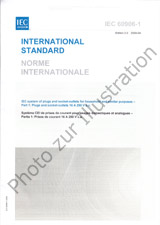Wir benötigen Ihre Einwilligung zur Verwendung der einzelnen Daten, damit Sie unter anderem Informationen zu Ihren Interessen einsehen können. Klicken Sie auf "OK", um Ihre Zustimmung zu erteilen.

IEC 61970-302-ed.2.0
Energy management system application program interface (EMS-API) - Part 302: Common information model (CIM) dynamics
Name übersetzen
NORM herausgegeben am 31.1.2024
Informationen über die Norm:
Bezeichnung normen: IEC 61970-302-ed.2.0
Ausgabedatum normen: 31.1.2024
SKU: NS-1165339
Zahl der Seiten: 1752
Gewicht ca.: 5287 g (11.66 Pfund)
Land: Internationale technische Norm
Kategorie: Technische Normen IEC
Kategorie - ähnliche Normen:
Die Annotation des Normtextes IEC 61970-302-ed.2.0 :
IEC 61970-302:2024 specifies a Dynamics package which contains part of the CIM to support the exchange of models between software applications that perform analysis of the steady-state stability (small-signal stability) or transient stability of a power system as defined by IEEE / CIGRE, Definition and classification of power system stability IEEE/CIGRE joint task force on stability terms and definitions. The model descriptions in this document provide specifications for each type of dynamic model as well as the information that needs to be included in dynamic case exchanges between planning/study applications. The scope of the CIM Dynamics package specified in this document includes: • standard models: a simplified approach to describing dynamic models, where models representing dynamic behaviour of elements of the power system are contained in predefined libraries of classes which are interconnected in a standard manner. Only the names of the selected elements of the models along with their attributes are needed to describe dynamic behaviour. • proprietary user-defined models: an approach providing users the ability to define the parameters of a dynamic behaviour model representing a vendor or user proprietary device where an explicit description of the model is not provided by this document. The same libraries and standard interconnections are used for both proprietary user-defined models and standard models. The behavioural details of the model are not documented in this document, only the model parameters. • A model to enable exchange of models’ descriptions. This approach can be used to describe user defined and standard models. • A model to enable exchange of simulation results. This second edition cancels and replaces the first edition published in 2018. This edition constitutes a technical revision. This edition includes the following significant technical changes with respect to the previous edition: a) The majority of issues detected in IEC 61970-302:2018 are addressed; b) IEEE 421.5-2016 on Excitation systems is fully covered; c) The IEEE turbine report from 2013 was considered and as a result a number of gas, steam and hydro turbines/governors are added; d) IEC 61400-27-1:2020 on wind turbines is fully incorporated; e) WECC Inverter-Based Resource (IBR) models, Hybrid STATCOM models and storage models are added; f) The user defined models are enhanced with a model which enables modelling of detailed dynamic model; g) A model to enable exchange of simulation results is added; h) The work on the HVDC models is not complete. The HVDC dynamics models are a complex domain in which there are no models that are approved or widely recognised on international level, i.e. there are only project-based models. At this stage IEC 61970-302:2022 only specifies some general classes. However, it is recognised that better coverage of HVDC will require a further edition of this document; i) Models from IEEE 1547-2018 "IEEE Standard for Interconnection and Interoperability of Distributed Energy Resources with Associated Electric Power Systems Interfaces" are added. j) Statements have been added to certain figures, tables, schemas, and enumerations throughout the document that indicate that they are reproduced with the permission of the UCA International User Group (UCAIug). These items are derived from the CIM. IEC 61970-302:2024 specifie un paquetage dynamique (Dynamics) contenant des extensions du modele dinformation commun (CIM). Il sagit dassurer lechange des modeles entre les applications logicielles qui procedent a lanalyse de la stabilite en regime etabli (stabilite en petits signaux) ou de la stabilite transitoire dun systeme de puissance comme cela est defini dans le document Definition and classification of power system stability (Definition et classification de la stabilite des systemes de puissance) du groupe de travail commun IEEE/CIGRE sur les termes et definitions relatifs a la stabilite. Les descriptions de modeles indiquees dans le present document donnent des specifications pour chaque type de modele dynamique, ainsi que des informations qui doivent etre incluses dans les echanges de cas dynamiques entre les applications de planification/detude. Le domaine dapplication du paquetage CIM Dynamics specifie dans le present document inclut: • des modeles normalises: une approche simplifiee qui vise a decrire des modeles dynamiques, les modeles representant le comportement dynamique des elements du systeme de puissance qui sont contenus dans des bibliotheques predefinies de classes interconnectees de maniere normalisee. Seuls les noms des elements selectionnes des modeles, accompagnes de leurs attributs, sont necessaires a la description du comportement dynamique; • des modeles proprietaires definis par lutilisateur: approche qui donne a lutilisateur la possibilite de definir les parametres dun modele de comportement dynamique representant le dispositif proprietaire dun fournisseur ou dun utilisateur lorsque le present document ne donne pas de description explicite du modele. Les memes bibliotheques et interconnexions normalisees sont utilisees tant pour les modeles proprietaires definis par lutilisateur que pour les modeles normalises. Les details comportementaux du modele ne sont pas documentes dans le present document, seuls les parametres du modele le sont; • un modele dechange des descriptions des modeles. Cette approche peut etre utilisee pour decrire les modeles definis par lutilisateur et les modeles normalises; • un modele dechange des resultats de simulation. Cette deuxieme edition annule et remplace la premiere edition parue en 2018. Cette edition constitue une revision technique. Cette edition inclut les modifications techniques majeures suivantes par rapport a ledition precedente: a) la majeure partie des problemes detectes dans lIEC 61970-302:2018 ont ete resolus; b) l’IEEE 421.5-2016 relative aux systemes dexcitation est integralement couverte; c)
Empfehlungen:
Aktualisierung der technischen Normen
Wollen Sie sich sicher sein, dass Sie nur die gültigen technischen Normen verwenden?
Wir bieten Ihnen eine Lösung, die Ihnen eine Monatsübersicht über die Aktualität der von Ihnen angewandten Normen sicher stellt.
Brauchen Sie mehr Informationen? Sehen Sie sich diese Seite an.



 Cookies
Cookies
